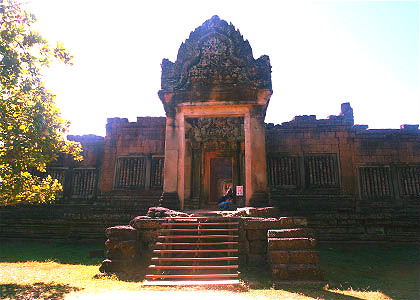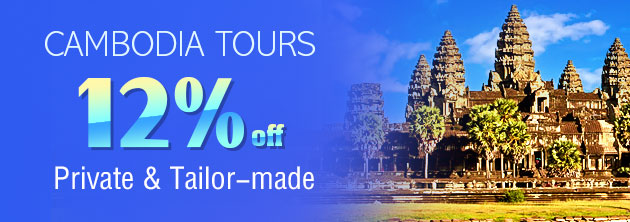Banteay Samre Temple
The temples of ancient Angkor have fascinated curious minds all around the world for a long time. Tourists started flocking to Cambodia to catch a glimpse of the ruins of the once-glorious temples.As one of ancient Angkor’s most prominent temples, Banteay Samre was named a UNESCO World Heritage Site and is considered by many to be a must-visit destination in the Angkor Archaeological Park. Here we will delve deeper into the origins of Banteay Samre, its architectural highlights and all the reasons why you should visit the temple.

Banteay Samre, Cambodia
|
The Story Behind the Name
The temple was named after the people who used to live in this area during the days of the Angkor Empire. The Samre people, an ancient Indochinese ethnic group, were the inspiration behind the christening of this particular Angkor temple.A Temple from the 12th Century
While archaeologists’ research work has revealed the origins of many prominent Angkor temples, the exact origins of the Banteay Samre temple remain unknown.According to researchers’ studies and estimates, the temple was constructed across the reign of two famous Khmer rulers, King Suryavarman II, who ruled during the late 11th century, and King Yasovarman II, who ruled during the early 12th century.
A Product of 20th Century Restoration Efforts
In the 1930s, Banteay Samre and several other Angkor temples were discovered in the middle of the dense Cambodian jungles by travelers and explorers.What they found back then resembled neither the temple that existed during the rule of the Angkor Empire nor the temple that you would get to witness now.
Thick greenery covered the temple and it was in a state of collapse and disrepair. On seeing the condition of the temple, restorers immediately got to work. Over the years, they put in as much effort as they could to transform the temple from a state of ruin to how it was originally.
The Cucumber King Legends
The Banteay Samre Temple has a story associated with it that has become a part and parcel of Cambodian folklore. It is said that once there lived a local farmer who was known for cultivating the tastiest cucumbers.After he gifted the king some of them, the king ordered him to kill anyone he suspected of entering his farm and stealing his cucumbers.
A few days later, the king himself went to the cucumber field as he could not get over their taste. Unfortunately, the farmer killed the king as he could not recognize him.
As the king had no sons, the decision to choose the next king was given to the Royal Elephant. The elephant signaled for the farmer to be crowned the next king. However, this did not go down well with the royal servants, who treated the new king with utter disrespect.
Frustrated, the new king left the Royal Palace and took up residence at the Banteay Samre Temple.

The Laterite Walkway in Banteay Samre Temple
|
The Temple’s Architectural Highlights
Originally, the Banteay Samre Temple was built in dedication to the Hindu God Shiva, but it was a place of worship not just for Hindus, but also for Buddhists. This is evident from the fact that the temple features depictions from both Buddhist and Hindu mythology.However, when King Jayavarman VIII came into power, he wiped out a lot of the Buddhist depictions; something that restorers haven’t been able to make right. But the temple still has a lot of architectural highlights that you are sure to find fascinating. Some of them are:
• The laterite walkway that is 200 meters (656 ft.) in length and features depictions of Nagas(multi-headed snakes in Hindu mythology)
• The pools on either side of the laterite walkway
• The terrace featuring lion statues, which guard the main temple
• The second enclosure of the temple that is surrounded on all sides by galleries
• Pediments and lintels on the second enclosure’s gopuras(towers) that feature carvings depicting famous scenes from Hindu mythology such as:
1. The fight between Lord Rama and Ravana from Ramayana, a Hindu epic
2. The Hindu God of War, Indra, riding Airavata, his three-headed elephant
3. Hanuman carrying a whole mountain to save the injured Lakshmana, Lord Rama’s brother, during the battle against Ravana’s forces
How to Reach Banteay Samre
Banteay Samre is situated along Road 810. One of the most notable landmarks near the temple is another prominent Angkor temple, East Mebon.The temple is approximately 20 km (12.4 mi) from the nearest city, Siem Reap. Taxis and tuk-tuks are both available and so are motorbikes and bicycles (rentals). The best way to experience the temple along with its nearby attractions is to go for a tour that drivers of tuk-tuks and taxis typically charge $25 for.
Ticket & Entry Fee
To enter the temple, you need to have the Angkor temple pass, which you can purchase from the ticket counter in front of the entrance gate of the Angkor Archaeological Park. Prices for the passes are as follows:• One-day pass: $37
• Three-day pass: $62
• Seven-day pass: $72

